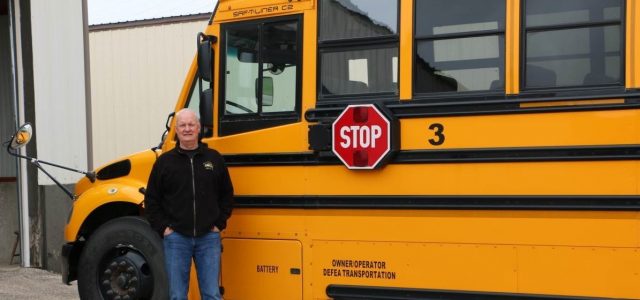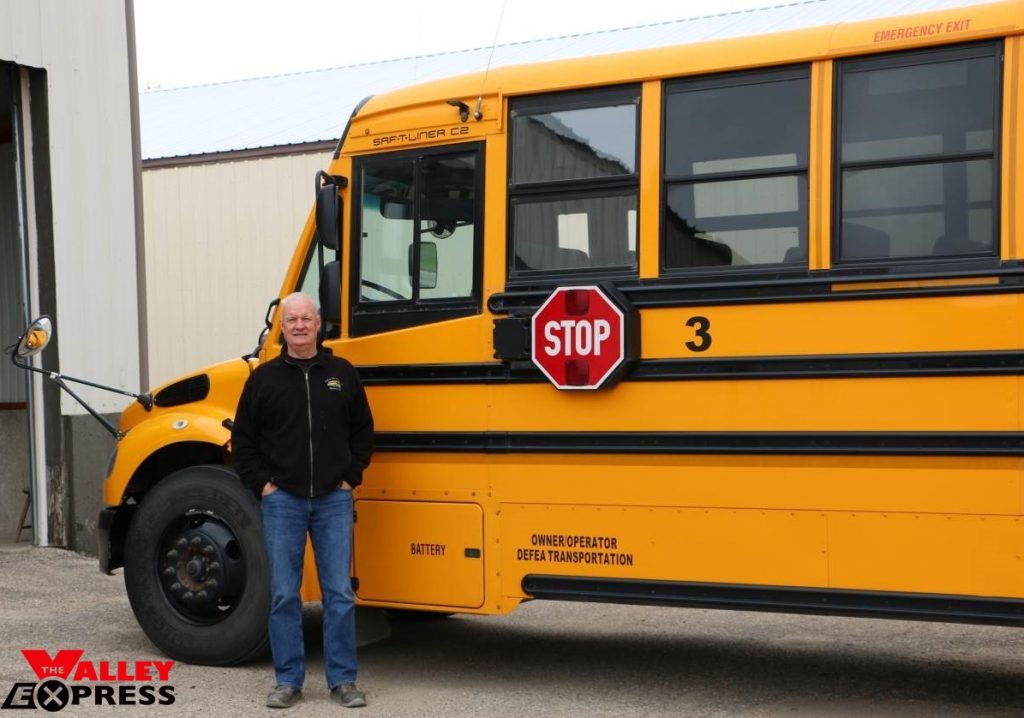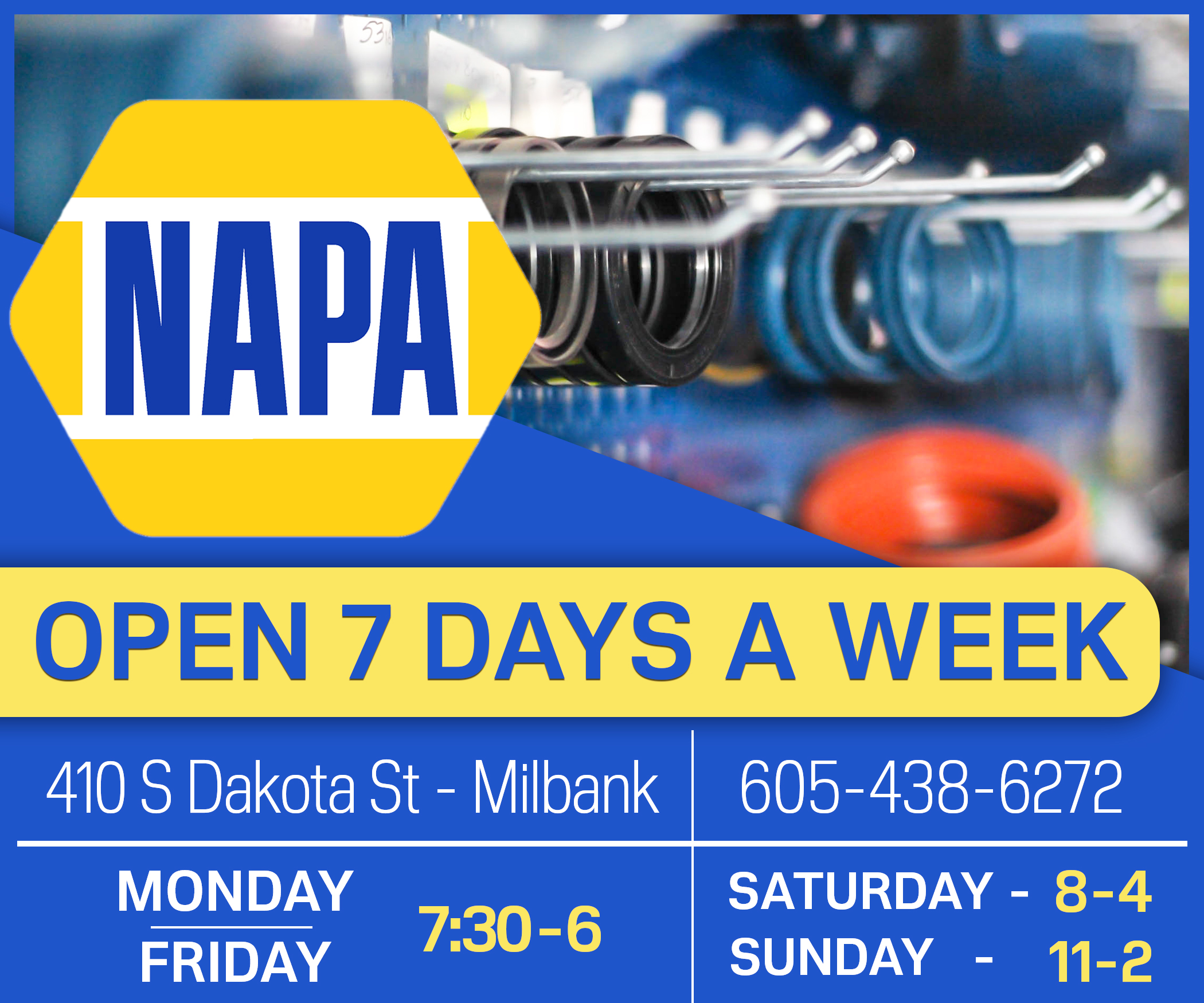Pat DeFea Has Helped Kids Get to School for Almost 40 Years
Local News December 12, 2022 Staff 1


Pat DeFea has kept the wheels on the bus going round and round for Milbank’s kids for 24 years. Pat and his wife Steph have owned DeFea Transportation, the company that contracts with the Milbank School District for school bus service, since he purchased the business from the Henze family in 1999. The Henzes created the company in 1964 when township schools started consolidating with Milbank. Pat drove a bus route for the Henzes for 14 years before he bought the business.
He still occasionally drives, Steph (Stehly); his dad, the late Jim DeFea; and Pat’s brother Mark have also taken a turn at the wheel. They are driving towards rivaling Carl Fisher, who holds the Guinness Book of World Records for the longest career as a school bus driver. Fisher drove a school bus in Pleasant Hope, Missouri, for 66 years. Today, December 12, Mr. Fischer will light 92 candles to celebrate his birthday.
When it comes to safety, school buses get an A+ and a big gold star. Pat said, “A school bus is the safest form of transportation we have.” If you calculate passenger miles, the commercial airliner comes out ahead. But imagine trying to get the kids to Milbank Elementary in a Boeing 737. Children are 70 times more likely to get to class safely on a school bus than in a family car, according to the National Highway Traffic Safety Administration (NHTSA).
“I think in our 24 years, we’ve had three accidents,” Pat said. “Once, there was a heave-over by Strandburg. Two big heaves in the road. It was bad. Our bus driver went over it really slowly; There was a girl who had her leg underneath the seat, and when the bus kicked up, she broke her leg. She’s the only person who has ever gotten hurt.”
The news isn’t quite as good for deer, though. Pat estimates his buses hit between five and 10 deer a year. “Earlier this fall, we hit a deer. That deer came from the side, and it pushed the bumper back into the tire. It put an enormous hole in the tire. It probably pushed the bumper back two and a half feet. I couldn’t believe it. Usually, the deer just kind of glance off”
“A lot of people ask me why we don’t install seat belts on our school buses?” Pat explained, “The National Transportation Safety Board (NTSB) did a two-year study. I’m going to say it was about 10 years ago. They found that lap belts do more harm to kids than good, and shoulder belts would save one life a year.”
School buses are built heavier and designed to distribute crash forces differently than cars. Pats said, “A school bus is made to hold one and a half times its weight on the roof. The glass is also laminated. So if the bus tips over, nobody is going to fall out.”
Pop quiz! What color is a school bus? You undoubtedly know the answer, but do you know why school buses are yellow? It’s all about safety, too. Frank Cyr, a Nebraskan, who incidentally first taught in Winner, South Dakota, was the driving force behind standardizing school buses in 1939.
Cyr invited a group of educators, engineers, and bus and paint manufacturers to convene with the goal of determining the most visible color to paint a school bus. establishing a new standard of school bus safety. When the vote was finally taken, the conventioneers determined it was easiest to read the black lettering, especially in the dim light of early morning and evening, on a particular shade of yellow. They dubbed it National School Bus Chrome. Later, it was renamed National School Bus Glossy Yellow when they removed the cancer-causing “chrome” from the paint. It’s the shade you see on nearly every school bus today.
During a raging Midwestern blizzard, it’s hard to see anything, but a huge hulk of glossy yellow offers the best chance of being noticed.
Painting school buses School Bus Glossy Yellow is not a federal law. It is regulated by each state.
Pat also notes he is not required to put “Milbank School District” on the outside of his 15 buses. The vehicles, however, must be identified with either the school name or the owner-contractor of the bus. And he points out, “See how the license plate reads ‘BUS’. A ‘BUS’ plate means it’s owned by a contractor. If it’s a school-owned vehicle, the plate starts with an ‘S’ and then has a four-digit number.”
With both the business and the school names emblazoned on all of his buses, Pat likens it to his signature and the school’s signature. He views it as a stark reminder to himself and to his drivers of the seriousness of their responsibility.
“We have a fair-sized district,” Pat said. “We drive 10 bus routes. They each cover roughly between 40 and 65 miles. One each morning and one in the afternoon. It comes out to just a little under a thousand miles a day. Our school district is 489 square miles. Some people think that’s a lot, but Groton, Britton, and Sisseton, are probably 700 to 900 square miles. He adds, “ If you live in Milbank and live south of 12th Avenue, west of Highway 15, or north of Highway 12 in town, you’re eligible to ride. We run just one route that doesn’t have any city stops at all.” During a regular travel day, Pat’s buses go through 150 to 200 gallons of fuel.
“We do extra activities, too,” he mentions and rattles off the day’s schedule. I’d say we do 275 activity trips during the school year and probably travel somewhere between 25,000 and 30,000 activity miles.”
“There’s just a ton of stuff going on, and we’re going so far. In the Northeast Conference, a lot of our competition is down by Sioux Falls. We play Madison, Tri Valley, Dell Rapids, Colton, Vermillion, and Dakota Valley in North Sioux City.” Pat, who graduated from MHS in 1976, said, “When I was in school, the farthest we went was Redfield.”
“People also ask me, ’Why do you need that activity bus?’ He points to the white bus wrapped in maroon and gold with a stylized Bulldog on its side. I usually say, ‘Well, it has air ride and it has air conditioning. The heat stays really even on it. You can set it at 70, and that’s what it’ll be. In a school bus, it might vary by 20 degrees.”
I remember one year I took the kids to Dakota Valley for football before we had the activity bus. It was 90 degrees outside. Those boys were beat by the time we got there. We also go to Rapid City two or three times a year. We took the cross-country kids to Grand Forks. For some of the varsity stuff, we go a long way.”
Pat said he doesn’t see an electric school bus in Milbank’s fleet anytime soon. “They aren’t practical for our area or for our budget. Each of our buses travels about a hundred miles a day, and there’s nobody here to fix an electric one.” An electric school bus is estimated to cost between $350K and $400K. A typical repower costs between $125K and $175K, depending on the battery size.
Pat says some districts are transitioning to straight gasoline and some areas are pushing propane. “I asked Superintendent Downes, ‘Why would I want to buy a propane bus? The first time it breaks down I’ll have to have it towed to Sioux Falls to get it fixed. I’ll also have to put in a propane fueling station, which I’m guessing would cost 30 grand or more.’” Plus, he notes, propane-powered buses and cold weather are not the best buddies.
“We need the speed and the performance of a diesel out on the highway, and we have really good luck with our diesels. The mileage is pretty good; they start good, and have lots of power. Gasoline’s fine for driving around town, but you’re probably not going to get any heat out of it that way. You have to work the engine to make it warm up. Plus, the body on this bus will wear out long before the engine!”
Is Pat also responsible for the whoops and hollers erupting across the county when kids hear school is cancelled? “Usually,” he said with a laugh. “In the wintertime, when the weather’s bad, I leave home about 4:15 or 4:30 and drive around in the country. Then, I call Mr.Downes. With technology today, it’s not as tough to figure out what to do. Wind is the worst thing. In the last 10 years, it seems like the wind just blows so hard. That, of course, makes it difficult to see.”
There have been days, though, where we’ve had five buses stuck all over the place. You can guess how that gets people cranked up!” How does he get them out? “Once in a while I can’t, he said, “but usually I can. A lot of times it’s just one wheel that’s come off the pavement. “I can’t tell you how many times I get to where a bus is stuck and somebody says, ‘You’re not gonna get that thing out.’ He laughed again. “I say, ‘You’d better get out of the way.’ That’s probably the worst thing about my job – pulling buses out of the snow. I’d say in the last 10 years, though, we haven’t had to go out nearly as much.”
How long does it take to warm up a big, yellow bus in the winter? ”In the mornings I get the buses going early. Because I know when every driver leaves,” Pat said. “I move out three or four and line them up. Usually, by the time the driver gets to their first stop, even if it’s 20 below, the bus is pretty warm inside. The oldest bus we run every day is a ‘16, I bought them all new between 2016 and 2019 so they heat really well. Most drivers don’t even wear a coat.”
The driver who leaves the earliest departs around 6:10 a.m, and the later ones take off around 6:50 a.m. “We get the kids to school by about 7:50 so they can eat breakfast,” Pat said. “In the afternoon, drivers leave here at 3:05 and the last one gets back around five o’clock. The latest ones come in from the Stockholm route and the one that goes south of Revillo.”
Most of the routes have the same driver every morning and every night. “My brother Mark knows almost all the routes. My wife knows all the routes. I try to get our drivers to learn at least two routes.”
He also said,” I have no trouble finding bus drivers. Everybody I hire has to take a pre-employment drug test and there’s random drug testing. They also undergo a background check. We have four women drivers, including my wife.
“This year, we’re paying drivers $100 a day,” Pat said. “A couple of routes pay a little more, but it’s $50 for the morning, and $50 for the afternoon. Drivers work about three and a half hours, so I think they’re getting paid pretty well. But they have a lot of responsibility, too. Pat said, “I know some schools are having a hard time getting people to drive for activities, but for activity trips, we pay $21 an hour from the time the bus leaves till it gets back.”
He handles most of the maintenance himself at the bus barn. “If I have def work, an engine type of thing, or a brakes issue, I usually take it over to Sumners. But, I change all the oil and clean and fix lights and heaters and seats. Those kinds of things.”
“When people ask me, ‘Where can I catch up with you tomorrow?’ I say, ‘Here.’ They are surprised I don’t go home during the day. If I do get home, it’s for half an hour for lunch. That’s it. I’m lucky if I’m home 12 hours a day.”
Pat said, “I signed a five-year contract with the school. If I stay healthy, I’m going to keep working for a while, but I know I can’t keep doing it forever. It’s a lot of work.”
“Like windshields.” he said. “Windshields get bugs on them.” Pat said,‘’I tell my guys, ‘Don’t get up there. Tell me when it needs to be done.’ I don’t want one of them to fall and get hurt. I usually clean the windows a couple of times a week in warmer weather. Especially when we go to Aberdeen and come back through Waubay and Webster. It’s like you put grease on the windshield.”
Each bus also gets washed at least once a week. “That’s quite a job,” he said. “I have a big pressure washer that heats the water to 300 degrees, so it really takes stuff off. Actually, with that pressure washer, I could probably blow the paint off the side of the bus, but I still have to get up there and scrub the windshield. It’s unbelievable. The bugs are like glue.”
When Pat decides to retire, he says it probably won’t be difficult to find a buyer. “I could be out of here tomorrow.” There are more big companies now. One big dealer has talked to me. They’ve acquired 14 locations now. They just took over Aberdeen, and they have Dell Rapids and Tri-Valley.”
“When I sell, I’d really prefer if someone local would buy it,” he emphasized. “If it’s an out-of-town buyer, I’d like to see something in the contract with the school that requires an onsite manager.”
“My wife and some of my employees say, ‘You like this job too much. You’re never going to quit.’” Pat just grins. He seems content to play his part in getting thousands of kids to school. As Hubert Humphrey said, “The road to freedom –here and everywhere on earth-– begins in the classroom.” What Humphrey failed to mention is: for many kids, that road starts a few miles earlier on a school bus.











